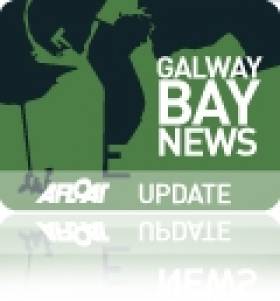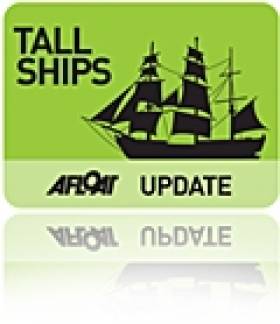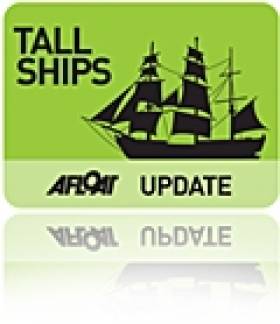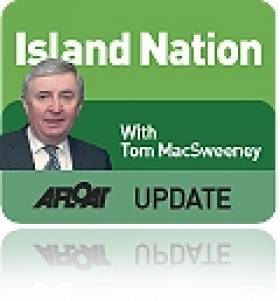Displaying items by tag: Economy
Galway In Talks to Attract Cruise Liners
World tourism bosses and cruise line operators will be headed to Galway next month for high-powered talks aimed at transforming the city into a global destination port.
The Connacht Sentinel reports that execuives from Fáilte Ireland, the Galway Harbour Company and Galway Chamber of Commerce will meet a delegation that will include Jamaica's head of tourism and some of the world's largest cruise line operators to discuss attracting business to the redeveloped port.
As previously reported on Afloat.ie, the proposed €200 million redevelopment of Galway Harbour - which will increase berthing space to accommodate cruise ships - has received approval to submit a planning application to An Bord Pleanála.
Galway West Deputy Brian Walsh, who helped push forward the development plan and will also meet the delegation at the end of September, said that the Galway Harbour Company has set a target of 50 cruise ships a year - which could bring in an extra €40 million annually to the local economy.
The Connacht Sentinel has more on the story HERE.
Ireland 'Can Benefit from Nurturing Sailing'
Two recent letters in The Irish Times serve as a "reminder of the high value of sailing to the social and economic health of Ireland".
Enda O Coineen - who helped bring the Volvo Ocean Race to Ireland - writes on Saturday last of the "shame" of becoming "quayside bystanders" that many felt welcoming the Norwegian tall ship Statsraad Lehmkuhl to Dublin when Ireland's youth ocean sail training scheme is being ended due to a 100% budget cut.
Echoing his sentiments, Peter Vine asks: "Is it not time to acknowledge that this maritime nation can benefit enormously by nurturing sailing and a love of the sea among our young people?"
Vine argues that efforts towards a "new viable Tallship for Ireland deserve individual, corporate and Government support". Do you agree? Have your say in the comments below.
Tall Ships Races Could Mean Big Money for Waterford
This weekend's Tall Ships Races in Waterford could bring in up to €35 million to the local economy, according to Fáilte Ireland.
Gerry Breen of Fáilte Ireland also told The Irish Times that the event would complement the new Viking Triangle development in the city, which is hoped to be a major tourist attraction.
Des Whelan, chairman of the Waterford Tall Ships Race 2011, said the official website had registered nearly 200,000 hits, and hotels in the city are almost completely booked out.
Opening the weekend's festivties this evening are a fashion show on board the Russian sailing ship Mir, and a special concert by Roxy Music singer Bryan Ferry.
The first of three impressive fireworks displays will also light up Waterford's skies at 10.30pm tonight.
Finding Long-Term Value for Boat Buyers
BoatTest.com has posted a guide to getting the best long-term value from your next boat purchase.
With boat buyers increasingly seeing their purchases as personal assets and investments for the future in this tough economic climate, making the right choice is more important than ever.
'Long-term value' is the key phrase. It's not just about price, but fitting the needs of the owner, and depreciating less than the average boat in the class - even after many years of enjoyment.
The site reminds boat buyers to remember the difference between 'type' and 'class' when comparing models, and its ten-point guide breaks down everything you need to know when choosing a boat for enduring value.
Read the BoatTest.com guide to long-term value in boat buying HERE.
How Many Times Do I Have to Say the Sea is Vital to Ireland?
Ireland has the largest maritime area-to-land mass in the European Union, but derives only 1% of GDP from the maritime sector. At a time when the economy needs every benefit it can get this figure is startling, particularly when compared to countries with other extensive coastlines, such as Norway where the figure is 20%, Denmark where it is 11% and even the UK which has increased its figure to 5%.
Despite being an island nation with a strong dependency on the sea, the Irish maritime economy is still in its infancy, both in terms of investment and of recognition.
Once again the importance of the sea was shown in the pre-Christmas weather problems. When air transport again failed the public, the ferries continued to operate. When road transport needed salt for gritting to keep roads open, it was ships which brought the salt to Ireland.
How many times do I have to challenge the ignorance and stupidity of the State, of Government, towards the sea? How many times do I have to remind the public of how dependent we are on the sea as an island nation?
Though still considered a low priority by Government, the maritime sector is worth €3 billion to the nation and supports 440,000 direct and indirect jobs. According to the Marine Institute in the "SeaChange Programme," this could be increased by at least 50%.
In Cork the Coastal and Marine Resources Centre which is part of UCC's Environmental Research Institute and has been working out of the Naval Base on Haulbowline Island has changed its name and is planning to move to a new maritime research facility. It has become the "Coastal and Marine Research Centre".
For over ten years the CMRC has been promoting the use of integrated coastal zone management as a means of achieving sustainable development in the use of coastal and marine resources, including marine ecology, seabed mapping, coastal processes, remote sensing, geology and geomatics.
A new maritime research facility is planned at Ringaskiddy, adjacent to the National Maritime College, part of the announced intention to establish a Maritime and Energy Research Campus and Commercial Cluster. The Department of Communications, Energy and Natural Resources, Bord Gais and the UCC Glucksman Foundation contributed funding, together with €7.5m. from the Higher Education Authority. As part of the National Ocean Energy Strategy, it will "bring together on one site the people, their ideas and the infrastructure to support the development of ocean energy," according to MERC Chairman, Peter Coyle. "Our aim is to produce innovative technical solutions to support the development of the Irish maritime sector."
This will include ocean energy opportunities, such as wave power where Irish companies have been leading the way. Shipping, logistics and maritime transport, marine recreation, maritime security research and maritime space applications are amongst other aspects of research work to be undertaken in Ringaskiddy.
Valerie Cummins, who led the Coastal Marine Resources Centre over past years has been appointed Director of MERC and is being replaced as Director at the newly re-named Coastal and Marine Research Centre by Jeremy Gault.
This article is reprinted by permission of the EVENING ECHO newspaper, Cork, where Tom MacSweeney writes maritime columns twice weekly. Evening Echo website: www.eecho.ie

































































